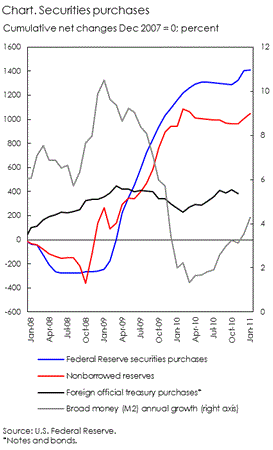Is QE dollar supportive?
28 February 2011
Ousmène Jacques Mandeng, Ashmore Investment Management
Some emerging markets policy makers and others have been protesting repeatedly that the U.S. Federal Reserve’s policy of quantitative easing (QE)—or credit easing—causes a weaker dollar and channels unwanted hot money flows into emerging markets. Actually, the opposite may be true. On the one hand, issuance of dollar liquidity due to substantial securities purchases by the Fed should weaken the dollar all else being equal. On the other hand, the explicit price support provided by the security purchases should support the dollar. Whatever effect dominates will determine to a large extent the dollar’s external value. The limited monetary expansion to date suggests that the effect of securities purchases is likely to dominate. Hence, QE seems dollar supportive.
The Fed’s balance sheet expanded considerably from total reserve bank credit of US$873 billion (6.2 percent of GDP) in December 2007 to US$2513 billion in February 2011 (17.2 percent of GDP). The expansion provided significant permanent liquidity injections with the adoption of outright securities purchases in January 2009 amounting to US$1750 billion through February 2011. This substantial monetary injec- tion, that is, a large additional supply of dollars, should from a portfolio point of view, undermine the value of the dollar. However, it is well known that most of that additional supply has remained on the Fed’s balance sheet in the form of nonborrowed reserves (nonborrwed reserves arise from the Fed’s debt holdings). Nonborrowed reserves are currently de facto congruent with excess reserves indicating that banks had not in- curred increases in deposits and hence broad money anywhere close to the pace of nonborrowed reserve accumulation (deposits normally attract reserve requirements such that broad money (M2) is a function of re- serve requirements). Broad money has been growing during 2010 through January 2011 on average 2.5 percent year-on-year (though expanding at a faster clip recently) far below the average pace of 6.5 percent in 2000-2009. The very low short-term interest rates, and hence the low opportunity cost of holding excess reserves for banks, also make banks reluctant to expand deposits and thus broad money. The Fed’s securities purchases have therefore largely been sterilised (Chart).
The Fed argues that the main purpose of QE is to affect—through its holdings of loans and securities—credit conditions for households and businesses. The Fed therefore deliberately affects the price of the securities it purchases and as such provides an explicit albeit unrevealed price guarantee. The existence of a price guarantee may encourage at least some holders of these securities to retain them. The largest purchases were made of mortgage-backed securities and treasury securities. While the former addresses naturally the faltering U.S. housing market, the latter seems to be looking towards an essential foreign constituency. In February 2009, Hillary Clinton appealed to the Chinese authorities to continue purchasing U.S. treasury securities. In March 2009, the start of Fed purchases of treasury securities coincided with the start of net selling of treasury securities by foreign official institutions. The Fed securities purchases may therefore have been directed to some extent at persuading foreign official institutions not to reduce to a significant extent their treasuries exposure in particular in the absence of fiscal consolidation.
The Fed’s unprecedented balance sheet extension may be the largest explicit dollar support action by the U.S. authorities yet and its largest unilateral foreign exchange intervention. Key will be for money not to start expanding fast. While the marginal effect of continued securities purchases on liquidity conditions may be doubtful, the effect on securities prices seems clear. The support of securities prices may have been essential to preventing larger scale liquidation of U.S. securities, in particular by the official sector, and hence possibly a disorderly exit from the dollar. The unwinding of QE therefore poses a huge dilemma. Not only are current asset prices hugely distorted due to QE and therefore actual price levels unknown, the withdrawal of the explicit price support will dent incentives to hold on to dollar-denominated securities more generally. This will weaken the dollar. It is the unwinding of QE then that may bring the hot money out of the U.S. many policy makers in emerging markets have dreaded so much.
